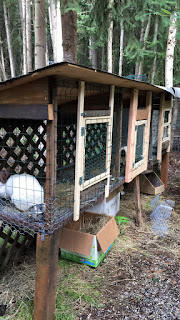This is the day that never ends and it goes on and on my friends......
Today was rabbit day. 23.5 lbs of rabbit harvested today. We have now moved all the babies that were in the temporary grow outs into the nicer grow outs to give them better accommodations. Our team of three (Edward, Nick and I) did great today! Nick did two of his own, almost completely by himself. It was a bit rocky starting off but before you know it we started picking up speed. And it was honeybee day. 1 gallon, 2 pints of honey harvested. Between the chicken we purchased as a chicken share from a friend, the rabbits, the berries I've picked this summer and all the other miscellaneous frozen bits I have stored away, our freezer is a bit full. Oh and never before have I had such a run on mason jars. Note to self, buy more mason jars. And soon. I still very badly need to make a batch of Apple Walnut bread. The apples that we picked are fermenting in the corner. Hhmm, maybe I should see if Edward wants to make hard cider with them? It's a thought! ...







